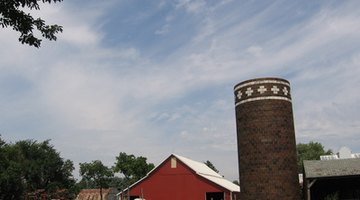How to Calculate the Volume of a Manure Pit
When you are raising animals on a farm, you have to take into account that they will produce manure that needs to be managed. Farmers often store animal waste in a manure pit, which is made by excavating the ground. Often manure pits are lined with concrete to prevent the waste from seeping into the earth and contaminating ground water. Sometimes manure is spread as fertilizer for growing crops, or processed into biofuel. Manure pits can be shaped like a circle, oval or rectangle. If you want to know how much manure you can store in a pit, you'll need to calculate its volume.

Step 1
Insert a long pole into the manure pit and mark when it hits the bottom. Measure the length from the end of the pole to the mark with a measuring tape to determine the pit's depth. Push a measuring wheel along the side of the pit to obtain the diameter of a round pit, or the length and width of a rectangular, oval or square-shaped pit.
Step 2
Measure the length, width and depth of a rectangular or square manure pit, and multiply the three numbers to get the volume. For example, a 20-foot-deep pit measuring 300 feet by 65 feet would have a volume of 390,000 cubic feet. Multiply cubic feet by 7.48 to convert the volume to 2,917,200 gallons of manure.
Step 3
Measure the diameter of a circular manure pit and divide it in half to get the radius. Multiply the radius by itself times the depth to get the volume. For example, a 10-foot-deep pit with an 80-foot diameter has a radius of 40 feet. Multiply 40 feet by 40 feet by 10 feet to get a volume of 16,000 cubic feet. Multiply the pit's cubic feet by 7.48 to convert the volume to 119,680 gallons.
Step 4
Measure the length, width and depth of an oval-shaped manure pit. Divide the length and the width in half and multiply them by the depth. For example, if you have a 12-foot-deep oval pit measuring 60 by 30 feet, multiply 30 by 15 by 12 to get a volume of 5,400 cubic feet. Multiply the pit's cubic feet by 7.48 to convert the volume to 40,392 gallons.
Step 5
Draw the outline of an irregularly shaped manure pit on graph paper to scale as accurately as you can, and then break it into sections corresponding to rectangles, circles or ovals -- whatever fits best. Calculate each section's volume, and add them up to estimate the total volume. If the pit does not have an even depth, measure the depth in several locations. Add up the amount of each depth, and divide by the number of depths you measured to obtain an approximate average depth. For example, if you measured 10 feet, 12 feet and 15 feet, that adds up to 37 feet. Divide 37 by three to estimate an average depth of about 12 feet.
References
Resources
Writer Bio
Julius Vandersteen has been a freelance writer since 1999. His work has appeared in “The Los Angeles Times,” “Wired” and “S.F. Weekly.” Vandersteen has a Bachelor of Arts in journalism from San Francisco State University.
Photo Credits
- The Farm image by bonjo from Fotolia.com
More Articles



